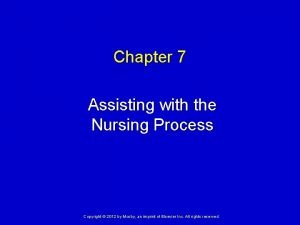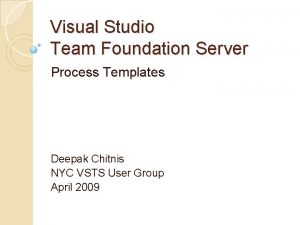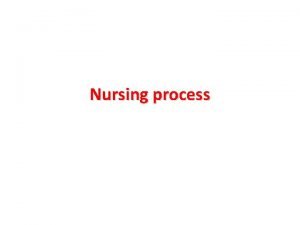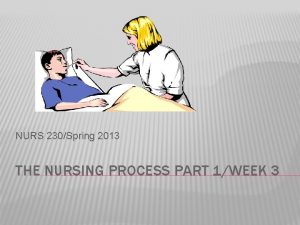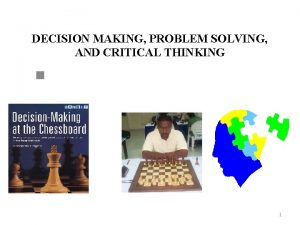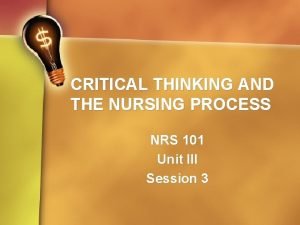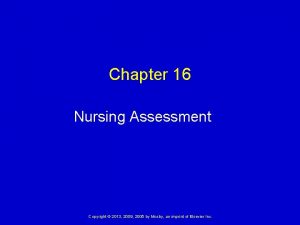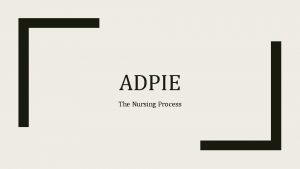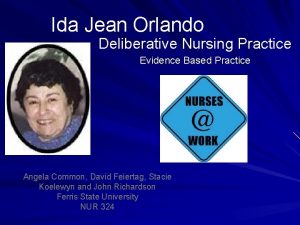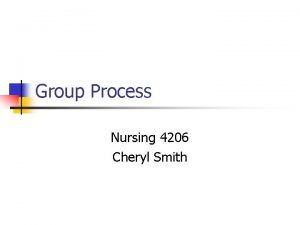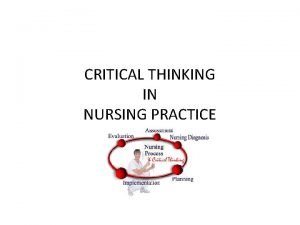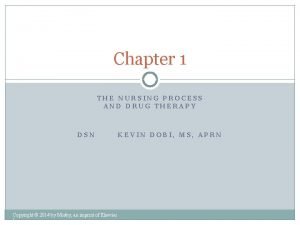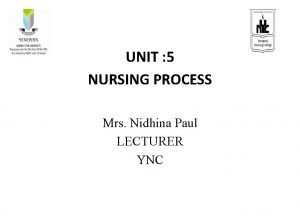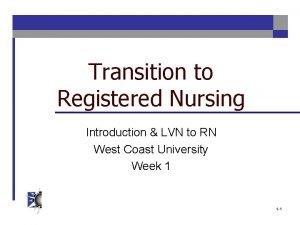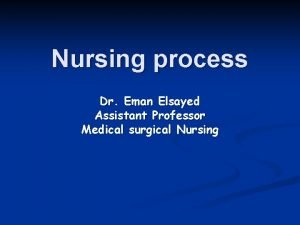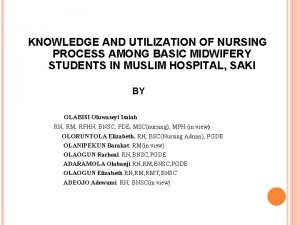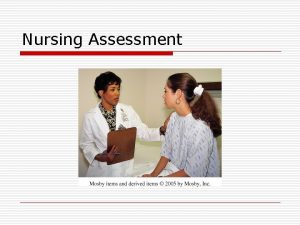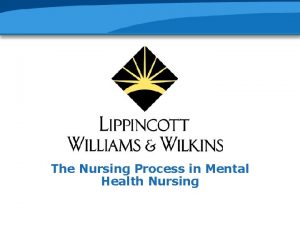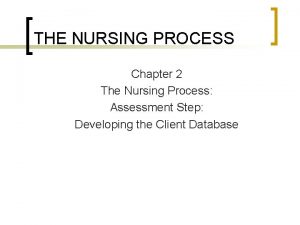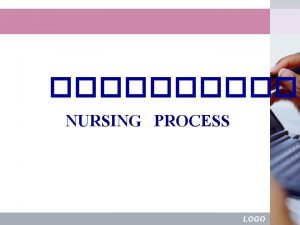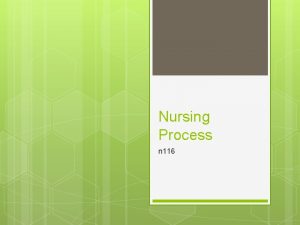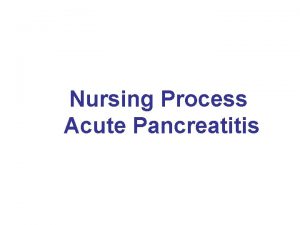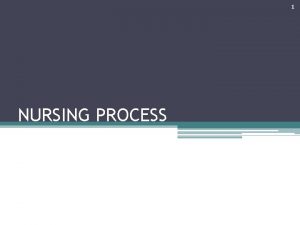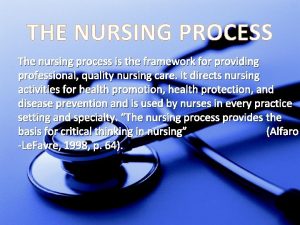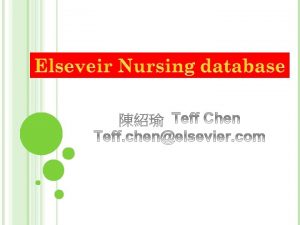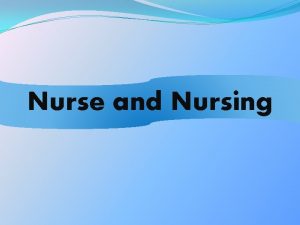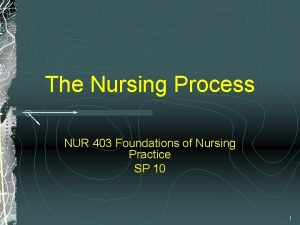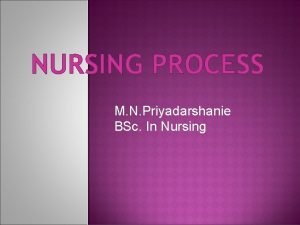Chapter 15 20 The Nursing Process Copyright 2017















































































- Slides: 79

Chapter 15 -20 The Nursing Process Copyright © 2017, Elsevier Inc. All Rights Reserved.

Giddens Concepts ◦ Clinical Judgment: an interpretation or conclusion about a patient’s needs, concerns, or health problems, and/or the decision to take action, use or modify standard approaches, or improvise new ones as deemed appropriate by the patient’s response. Copyright © 2017, Elsevier Inc. All Rights Reserved. 2

Historical Development of the Nursing Process ◦ The foundation of the Nursing Profession ◦ A problem solving approach for discovering the healthcare and nursing care needs of clients ◦ The American Nurses Association supports the nursing process as foundational for decision making and competent nursing care

Clinical Judgment in Nursing Practice ◦ Registered nurses (RNs) are responsible for making accurate and appropriate clinical decisions or judgments. ◦ Nurses must learn to question, wonder, and explore different perspectives and interpretations to find a solution that benefits the patient. Copyright © 2017, Elsevier Inc. All Rights Reserved. 4

Critical Thinking Defined ◦ Critical thinking is: ◦ The ability to think in a systematic and logical manner with openness to question and reflect on the reasoning process ◦ A continuous process characterized by open-mindedness, continual inquiry, and perseverance, combined with a willingness to look at each unique patient situation and determine which identified assumptions are true and relevant ◦ Recognizing that an issue exists, analyzing information, evaluating information, and drawing conclusions Copyright © 2017, Elsevier Inc. All Rights Reserved. 5

Critical Thinking Skills Copyright © 2017, Elsevier Inc. All Rights Reserved. 6

Concepts for Critical Thinking Copyright © 2017, Elsevier Inc. All Rights Reserved. 7

Reflection ◦ The ability to act on the basis of critical thinking comes with experience. ◦ Turning over a subject in the mind and thinking about it seriously is reflection. ◦ Reflection is not intuitive. Copyright © 2017, Elsevier Inc. All Rights Reserved. 8

Levels of Critical Thinking in Nursing Copyright © 2017, Elsevier Inc. All Rights Reserved. 9

Critical Thinking Competencies ◦ General critical thinking ◦ Scientific method ◦ Problem solving ◦ Decision making ◦ Specific critical thinking ◦ Diagnostic reasoning and inference ◦ Clinical decision making Copyright © 2017, Elsevier Inc. All Rights Reserved. 10

Critical Thinking Competencies (Cont. ) ◦ Nursing process as a competency ◦ Assessment ◦ Diagnosis ◦ Planning ◦ Implementation ◦ Evaluation Copyright © 2017, Elsevier Inc. All Rights Reserved. 11

Critical Thinking Competencies (Cont. )

A Critical Thinking Model for Clinical Decision Making ◦ Model components: ◦ ◦ ◦ Specific knowledge base Experience Nursing process competency Attitudes for critical thinking Professional standards Copyright © 2017, Elsevier Inc. All Rights Reserved. 13

Critical Thinking Synthesis ◦ Critical thinking and the nursing process go hand-in-hand in making quality decisions about patient care. Copyright © 2017, Elsevier Inc. All Rights Reserved. 14

Components of Critical Thinking Copyright © 2017, Elsevier Inc. All Rights Reserved. 15

Attitudes for Critical Thinking Copyright © 2017, Elsevier Inc. All Rights Reserved. 16

Developing Critical Thinking Skills ◦ Reflective journaling ◦ Define and express clinical experiences in your own words ◦ Meeting with colleagues ◦ Discuss and examine work experiences and validate decisions ◦ Concept mapping ◦ Visual representation of patient problems and interventions that shows their relationships to one another Copyright © 2017, Elsevier Inc. All Rights Reserved. 17

Managing Stress ◦ The work of professional nursing is difficult as you see patients endure suffering from disease and painful therapies and as you try to manage care responsibilities in busy, fast-paced work settings. ◦ Stress over a prolonged period or when extreme can lead to poor work productivity, impaired decision making and communication, and reduced ability to cope with clinical situations. Copyright © 2017, Elsevier Inc. All Rights Reserved. 18

Chapter 16 Nursing Assessment Copyright © 2017, Elsevier Inc. All Rights Reserved.

Five-Step Nursing Process Copyright © 2017, Elsevier Inc. All Rights Reserved. 20

Critical Thinking Approach to Assessment ◦ Assessment involves collecting information from the patient and from secondary sources (e. g. , family members), along with interpreting and validating the information to form a complete database. ◦ Two stages of assessment: ◦ Collection and verification of data ◦ Analysis of data Copyright © 2017, Elsevier Inc. All Rights Reserved. 21

Critical Thinking Approach to Assessment (Cont. ) Copyright © 2017, Elsevier Inc. All Rights Reserved. 22

Developing the Nurse-Patient Relationship for Data Collection ◦ Sources of data ◦ Patient (interview, observation, physical examination)—the best source of information ◦ Family and significant others (obtain patient’s agreement first) ◦ Health care team ◦ Medical records ◦ Scientific literature ◦ Database Copyright © 2017, Elsevier Inc. All Rights Reserved. 23

Types of Assessments ◦ Types include ◦ the patient-centered interview during a nursing health history. ◦ a physical examination. ◦ the periodic assessments you make during rounding or administering care. Copyright © 2017, Elsevier Inc. All Rights Reserved. 24

Types of Data ◦ Subjective ◦ Patient’s verbal descriptions of their health problems ◦ Includes sensations, feelings, values, beliefs, attitudes, and perception of personal health status and life situations ◦ Objective ◦ Observations or measurements of a patient’s health status ◦ Can be seen, heard, felt, or smelled ◦ Obtained through observation or physical examination Copyright © 2017, Elsevier Inc. All Rights Reserved. 25

Sources of Data ◦ From primary or secondary source ◦ Patient ◦ Family and significant others ◦ Health care team ◦ Medical records ◦ Other records and the scientific literature ◦ Nurse’s experience Copyright © 2017, Elsevier Inc. All Rights Reserved. 26

Sources of Data (Cont. ) ◦ Intuition ◦ The use of insight, instinct, and clinical experience to make clinical judgments about the client ◦ When assessment data is incomplete, sketchy, or vague, or when the client looks all right on the surface but the nurse senses that something is not quite right

The Patient-Centered Interview ◦ Motivational interviewing ◦ Effective communication ◦ Interview preparation ◦ Phases of an interview ◦ Orientation and setting an agenda ◦ Working phase ◦ Termination Copyright © 2017, Elsevier Inc. All Rights Reserved. 28

Interview Techniques ◦ Observation ◦ Open-ended questions ◦ Leading questions ◦ Back channeling ◦ Direct closed-ended questions Copyright © 2017, Elsevier Inc. All Rights Reserved. 29

Interview Preparation ◦ Occurs before the nurse meets the client to ensure the interview is productive ◦ Review client information ◦ Decide what data is to be collected ◦ Review literature pertinent to client’s developmental age, psychosocial aspects, and pathophysiologic considerations ◦ Assess self in regards to nurse-client relationship ◦ Seek assistance from healthcare team as needed ◦ Modify environment

Orientation and Setting an Agenda ◦ Rapport, clarification of roles, and alleviating anxiety occur ◦ Introductions and purpose of interview, including length, and method of data collection ◦ Establish rapport ◦ Observe nonverbal behavior ◦ Listen to client’s account of their health ◦ Validate information ◦ Use therapeutic communication skills ◦ Establish a verbal contract including goals of the interview

Working Phase ◦ The working phase where nurse and client work toward achieving the specific task or goal agreed upon ◦ Goal focused ◦ Encourage client communication of feelings, concerns, and questions ◦ Observe nonverbal behavior of client ◦ Facilitate goal attainment as needed

Termination ◦ The nurse-client relationship is completed ◦ Focus is reviewing goals or tasks attained any concerns ◦ Review goal or task attainment ◦ Summarize the highlights of the interview ◦ Encourage client expression of feelings

Validation ◦ Assessment complete ◦ Objective and related subjective data agree ◦ Additional data overlooked ◦ Differentiate between cues and inferences ◦ Avoiding jumping to conclusions

Nursing Health History ◦ During the patientcentered interview you will learn which components of history to explore Copyright © 2017, Elsevier Inc. All Rights Reserved. 35

Nursing Health History (Cont. ) ◦ Diagnostic and laboratory data ◦ Results provide further explanation of alterations or problems identified during the health history and physical examination ◦ Interpreting and validating assessment data ◦ Ensures collection of complete database ◦ Leads to second step of nursing process Copyright © 2017, Elsevier Inc. All Rights Reserved. 36

Chapter 17 Nursing Diagnosis Copyright © 2017, Elsevier Inc. All Rights Reserved.

Five-Step Nursing Process Copyright © 2017, Elsevier Inc. All Rights Reserved. 38

History of Nursing Diagnosis ◦ First introduced in 1950. ◦ In 1953, Fry proposed the formulation of a nursing diagnosis. ◦ In 1973, first national conference held. ◦ In 1980 and 1995, the American Nurses Association (ANA) included diagnosis as a separate activity in its publication Nursing: a Social Policy Statement. ◦ In 1982, North American Nursing Diagnosis Association (NANDA) was founded. Copyright © 2017, Elsevier Inc. All Rights Reserved. 39

Types of Nursing Diagnoses ◦ NANDA-I (2014) nursing diagnoses include: ◦ Problem-focused ◦ Risk ◦ Health promotion Copyright © 2017, Elsevier Inc. All Rights Reserved. 40

Copyright © 2017, Elsevier Inc. All Rights Reserved. 41

Copyright © 2017, Elsevier Inc. All Rights Reserved. 42

Problem Focused Nursing Diagnosis ◦ Human response to a health problem is being manifested ◦ Written as diagnostic label, related factor, and defining characteristics ◦ The supporting cues are found in the assessment data ◦ Impaired Physical Mobility related to decreased strength and endurance AEB unsteady gait

Risk Nursing Diagnosis ◦ Clinical judgement stating client is more vulnerable to develop problem than others in same situation ◦ Supported by risk factors ◦ Written as risk diagnostic label and related factor ◦ Risk for infection related to a site for organism invasion

Health Promotion Nursing Diagnosis ◦ Describes a client’s preparedness to implement behaviors to improve their health condition ◦ Written as diagnostic label ◦ Readiness for Enhanced Nutrition

Critical Thinking and the Nursing Diagnostic Process ◦ The diagnostic process requires you to use critical thinking. ◦ Helps to be thorough, comprehensive, and accurate when identifying nursing diagnoses that apply to your patients. ◦ The diagnostic reasoning process involves using the assessment data gathered about a patient to logically explain a clinical judgment or a nursing diagnosis. Copyright © 2017, Elsevier Inc. All Rights Reserved. 46

Data Clustering ◦ A data cluster is a set of cues, the signs or symptoms gathered during assessment. ◦ Data clusters are compared with standards to reach a conclusion about a patient’s response to a health problem. ◦ Each clinical criterion is an objective or subjective sign, symptom, or risk factor that, when analyzed with other criteria, leads to a diagnostic conclusion. Copyright © 2017, Elsevier Inc. All Rights Reserved. 47

Data Interpretation ◦ It is critical to select the correct diagnostic label for a patient’s need. ◦ When comparing patterns, judge whether the grouped signs and symptoms are expected for a patient (e. g. , consider current condition, history) and whether they are within the range of healthy responses. ◦ By isolating any defining characteristics not within healthy norms, you can identify a specific problem. Copyright © 2017, Elsevier Inc. All Rights Reserved. 48

Formulating a Three Part Nursing Diagnosis Statement ◦ Identify the correct diagnostic label. ◦ A related factor allows you to state the etiology, or cause, for a specific patient. ◦ Defining characteristics lists the evidence of the health problem, for a specific patient. Copyright © 2017, Elsevier Inc. All Rights Reserved. 49

Example ◦ Deficient Knowledge related to change in medications as evidenced by patient statement “I am not sure how this medication will help me. ”

Nursing Diagnosis: Application to Care Planning ◦ By learning to make accurate nursing diagnoses, your care plan will help communicate the patient’s health care problems to other professionals. ◦ A nursing diagnosis will ensure that you select relevant and appropriate nursing interventions. Copyright © 2017, Elsevier Inc. All Rights Reserved. 51

Chapter 18 Planning Nursing Care Copyright © 2017, Elsevier Inc. All Rights Reserved.

Five-Step Nursing Process Copyright © 2017, Elsevier Inc. All Rights Reserved. 53

Establishing Priorities ◦ Ordering of nursing diagnoses or patient problems uses determinations of urgency and/or importance to establish a preferential order for nursing interventions. ◦ Classification of priorities: ◦ High—Emergent ◦ Intermediate—non-life-threatening ◦ Low—Affect patient’s future well-being Copyright © 2017, Elsevier Inc. All Rights Reserved. 54

Role of the Patient in Goal/Outcome Setting ◦ Mutual goal setting includes the patient and family (when appropriate) in prioritizing the goals of care and developing a plan of action. Copyright © 2017, Elsevier Inc. All Rights Reserved. 55

Writing Goals and Expected Outcomes ◦ Must be patient-centered ◦ Goal ◦ A broad statement that describes the desired change in a patient’s condition, perceptions, or behavior ◦ Outcome ◦ Measurable change that must be achieved to reach a goal within a designated time period. ◦ Use SMART acronym ◦ ◦ ◦ Specific Measurable Attainable Realistic Timed Copyright © 2017, Elsevier Inc. All Rights Reserved. 56

Example ◦ The patient will be able to correctly state the indications for each medication by discharge.

Critical Thinking in Planning Nursing Care ◦ Nursing interventions are treatments or actions based on clinical judgment and knowledge that nurses perform to enhance patient outcomes. ◦ Nurses need to: ◦ Know the scientific rationale for the intervention ◦ Possess the necessary psychomotor and interpersonal skills ◦ Be able to function within a setting to use health care resources effectively Copyright © 2017, Elsevier Inc. All Rights Reserved. 58

Types of Interventions ◦ Nurse-initiated ◦ Independent—Actions that a nurse initiates ◦ Health care provider initiated ◦ Dependent—Require an order from a physician or other health care professional ◦ Collaborative ◦ Interdependent—Require combined knowledge, skill, and expertise of multiple health care professionals Copyright © 2017, Elsevier Inc. All Rights Reserved. 59

Standard Nursing Interventions ◦ Standardized interventions most often set a level of clinical excellence for practice ◦ Nurse- and health care provider–initiated standardized interventions are available in the form of clinical guidelines or protocols, preprinted (standing) orders, and Nursing Interventions Classification (NIC) interventions ◦ American Nurses Association (ANA) standards ◦ Quality and Safety Education for Nurses (QSEN) skill competencies Copyright © 2017, Elsevier Inc. All Rights Reserved. 60

Example ◦ 1. Provide a safe and clean environment. ◦ Rationale: to minimize injury to patient and nurse. ◦ 2. Provide prompt attention to call lights. ◦ Rationale: to minimize injury to patient. ◦ 3. Have call light within reach. ◦ Rationale: to minimize injury to patient and address patient needs quickly. Copyright © 2017, Elsevier Inc. All Rights Reserved. 61

Systems for Planning Nursing Care ◦ Nursing care plan = Nursing diagnoses, goals and expected outcomes, and nursing interventions, and a section for evaluation findings so any nurse is able to quickly identify a patient’s clinical needs and situation ◦ Reduces the risk for incomplete, incorrect, or inaccurate care ◦ Changes as the patient’s problems and status change ◦ Interdisciplinary care plan = Contributions from all disciplines involved in patient care ◦ Critical pathways= Patient care plans that provide the multidisciplinary health care team with activities and tasks to be put into practice sequentially. Copyright © 2017, Elsevier Inc. All Rights Reserved. 62

Chapter 19 Implementing Nursing Care Copyright © 2017, Elsevier Inc. All Rights Reserved.

Five-Step Nursing Process Copyright © 2017, Elsevier Inc. All Rights Reserved. 64

Critical Thinking in Implementation ◦ Clinical judgment ◦ Includes making appropriate conclusions about interventions to address a patient’s response to health conditions or a life process ◦ Requires nurse to use or modify standard approaches, sometimes improvise new ones Copyright © 2017, Elsevier Inc. All Rights Reserved. 65

Implementation Process ◦ Reassessing a patient ◦ Continuous process with each patient interaction ◦ Reviewing and revising the existing nursing care plan ◦ Allows you to validate a patient’s nursing diagnoses, review the care plan, and determine whether the nursing interventions remain the most appropriate for the patient’s needs Copyright © 2017, Elsevier Inc. All Rights Reserved. 66

Implementation Skills ◦ You are responsible for knowing when one type of implementation skill is preferred over another and for having the necessary knowledge and skill to perform each. ◦ Cognitive skills ◦ Interpersonal skills ◦ Psychomotor skills Copyright © 2017, Elsevier Inc. All Rights Reserved. 67

Direct Care vs. Indirect Care Direct Care Indirect Care • Treatments performed through interactions with patients • Treatments performed away from the patient but on behalf of the patient or group of patients • Medication administration • Managing the patient’s • Insertion of an environment (e. g. , safety intravenous (IV) infusion and infection control) • Counseling during a time • Documentation of grief • Interdisciplinary collaboration Copyright © 2017, Elsevier Inc. All Rights Reserved. 68

Direct Care ◦ Activities of daily living (ADLs) ◦ Performed in the course of a day, including ambulation, eating, dressing, bathing, and grooming ◦ Instrumental ADLs (IADLs) ◦ Skills such as shopping, preparing meals, house cleaning, writing checks, and taking medications. ◦ Physical care techniques ◦ The safe and competent administration of nursing procedures ◦ Lifesaving measures Copyright © 2017, Elsevier Inc. All Rights Reserved. 69

Direct Care (Cont. ) ◦ Counseling ◦ Teaching ◦ Controlling for adverse reactions ◦ Preventive measures Copyright © 2017, Elsevier Inc. All Rights Reserved. 70

Indirect Care ◦ Indirect care measures are nursing actions that manage the patient care environment and interdisciplinary collaborative actions that support the effectiveness of direct care interventions ◦ Communicating nursing interventions ◦ Written or oral ◦ Delegating, supervising, and evaluating the work of other staff members Copyright © 2017, Elsevier Inc. All Rights Reserved. 71

Chapter 20 Evaluation Copyright © 2017, Elsevier Inc. All Rights Reserved.

Five-Step Nursing Process Copyright © 2017, Elsevier Inc. All Rights Reserved. 73

Evaluative Measures ◦ Evaluative measures are assessment skills and techniques Copyright © 2017, Elsevier Inc. All Rights Reserved. 74

Compare Achieved Effect with Goals and Outcomes ◦ Compare clinical data, patient behavior measures, and patient selfreport measures collected before implementation with the evaluation findings gathered after administering nursing care. ◦ Evaluate whether the results of care match the expected outcomes and goals set for a patient. Copyright © 2017, Elsevier Inc. All Rights Reserved. 75

Interpreting and Summarizing Findings ◦ When you evaluate the effect of interventions, you interpret or learn to recognize relevant evidence about a patient’s condition ◦ Compare actual and expected findings Copyright © 2017, Elsevier Inc. All Rights Reserved. 76

Example ◦ Patient able to correctly state reasons for each medication being taken. Handouts provided for each medication to be taken at discharge. Patient verbalized understanding regarding handouts. Patients wife at bedside participating in teaching.

Care Plan Revision ◦ Modifying a care plan ◦ ◦ Reassessment Redefining diagnoses Goals and expected outcomes Interventions Copyright © 2017, Elsevier Inc. All Rights Reserved. 78

Practice Time! ◦ Check out the computer program Nursing Diagnosis on the computers in the nursing skills lab. Practice writing nursing diagnoses and formulating nursing care plans.
 Copyright secondary sara (2017) answers
Copyright secondary sara (2017) answers Nursing diagnosis format
Nursing diagnosis format Nursing process in psychiatric nursing
Nursing process in psychiatric nursing Chapter 5 assisting with the nursing process
Chapter 5 assisting with the nursing process Team foundation server demo
Team foundation server demo Hát kết hợp bộ gõ cơ thể
Hát kết hợp bộ gõ cơ thể Ng-html
Ng-html Bổ thể
Bổ thể Tỉ lệ cơ thể trẻ em
Tỉ lệ cơ thể trẻ em Gấu đi như thế nào
Gấu đi như thế nào Tư thế worm breton
Tư thế worm breton Bài hát chúa yêu trần thế alleluia
Bài hát chúa yêu trần thế alleluia Các môn thể thao bắt đầu bằng tiếng nhảy
Các môn thể thao bắt đầu bằng tiếng nhảy Thế nào là hệ số cao nhất
Thế nào là hệ số cao nhất Các châu lục và đại dương trên thế giới
Các châu lục và đại dương trên thế giới Công của trọng lực
Công của trọng lực Trời xanh đây là của chúng ta thể thơ
Trời xanh đây là của chúng ta thể thơ Mật thư anh em như thể tay chân
Mật thư anh em như thể tay chân Phép trừ bù
Phép trừ bù độ dài liên kết
độ dài liên kết Các châu lục và đại dương trên thế giới
Các châu lục và đại dương trên thế giới Thơ thất ngôn tứ tuyệt đường luật
Thơ thất ngôn tứ tuyệt đường luật Quá trình desamine hóa có thể tạo ra
Quá trình desamine hóa có thể tạo ra Một số thể thơ truyền thống
Một số thể thơ truyền thống Bàn tay mà dây bẩn
Bàn tay mà dây bẩn Vẽ hình chiếu vuông góc của vật thể sau
Vẽ hình chiếu vuông góc của vật thể sau Biện pháp chống mỏi cơ
Biện pháp chống mỏi cơ đặc điểm cơ thể của người tối cổ
đặc điểm cơ thể của người tối cổ Ví dụ giọng cùng tên
Ví dụ giọng cùng tên Vẽ hình chiếu đứng bằng cạnh của vật thể
Vẽ hình chiếu đứng bằng cạnh của vật thể Phối cảnh
Phối cảnh Thẻ vin
Thẻ vin đại từ thay thế
đại từ thay thế điện thế nghỉ
điện thế nghỉ Tư thế ngồi viết
Tư thế ngồi viết Diễn thế sinh thái là
Diễn thế sinh thái là Dạng đột biến một nhiễm là
Dạng đột biến một nhiễm là Thế nào là số nguyên tố
Thế nào là số nguyên tố Tư thế ngồi viết
Tư thế ngồi viết Lời thề hippocrates
Lời thề hippocrates Thiếu nhi thế giới liên hoan
Thiếu nhi thế giới liên hoan ưu thế lai là gì
ưu thế lai là gì Khi nào hổ con có thể sống độc lập
Khi nào hổ con có thể sống độc lập Sự nuôi và dạy con của hổ
Sự nuôi và dạy con của hổ Hệ hô hấp
Hệ hô hấp Từ ngữ thể hiện lòng nhân hậu
Từ ngữ thể hiện lòng nhân hậu Thế nào là mạng điện lắp đặt kiểu nổi
Thế nào là mạng điện lắp đặt kiểu nổi What is modular nursing
What is modular nursing Nursing care plan for ocd patient
Nursing care plan for ocd patient Pre and postoperative nursing management of cataract
Pre and postoperative nursing management of cataract Third step of nursing process
Third step of nursing process Example of community health nursing diagnosis statement
Example of community health nursing diagnosis statement Nursing process
Nursing process Nursing process theory
Nursing process theory Orlando nursing theory
Orlando nursing theory Disturbed thought process nanda
Disturbed thought process nanda Nursing process model
Nursing process model Subjective vs objective data
Subjective vs objective data Factors that influences communication
Factors that influences communication Traditional problem solving process nursing
Traditional problem solving process nursing Medical diagnosis and nursing diagnosis difference
Medical diagnosis and nursing diagnosis difference Nrs 101
Nrs 101 Chapter 16 nursing assessment
Chapter 16 nursing assessment Adpie nursing process examples
Adpie nursing process examples Patient admission process in hospital
Patient admission process in hospital Summary of nursing process
Summary of nursing process Define seminar in nursing management
Define seminar in nursing management Application of orlando's theory
Application of orlando's theory Group process in nursing
Group process in nursing Medical diagnosis and nursing diagnosis difference
Medical diagnosis and nursing diagnosis difference Importance of critical thinking in nursing process
Importance of critical thinking in nursing process What are the nursing process
What are the nursing process Anxiety goals nursing
Anxiety goals nursing Nursing process in drug therapy
Nursing process in drug therapy Objective data
Objective data Lpn vs rn
Lpn vs rn Overview of education in health care
Overview of education in health care Define nursing process
Define nursing process Bnsc
Bnsc Jennifer dixon accident
Jennifer dixon accident



